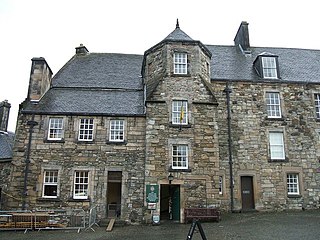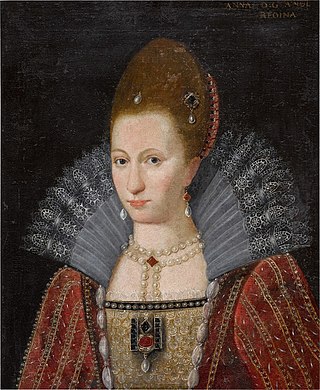Drinksilver was a kind of tip or gratuity given to artisans in Early Modern Scotland, a sum of money suitable for buying drinks and celebrating. [1] Records of payments give insights into labour, service, and patronage. [2]
Contents

Drinksilver was a kind of tip or gratuity given to artisans in Early Modern Scotland, a sum of money suitable for buying drinks and celebrating. [1] Records of payments give insights into labour, service, and patronage. [2]

Building accounts written in Latin use the word bibalia for these payments for drinks. An account for building a bridge over the River Tay mentions bibalia given to two blacksmiths Alastair and Andrew Smith and their workers. [3] The Scottish royal accounts have numerous references to gifts of money described as "drinksilver". The money was given to construction workers, artillery-men, tailors, and other makers. The gifts were made during royal visits or at the completion of a phase of work. Mary of Guelders gave 20 shillings to masons at the College of St Salvator at the University of St Andrews in 1461. [4] James IV gave masons working at Linlithgow Palace in September 1491 drinkilver at the "pending" of three stone vaults. The completion of arched vaulting was a significant milestone in a construction project. In November 1497 he gave masons at Linlithgow a tip of 9 shillings. [5]
In September 1561 drinksilver was given to the tailor "boys" who had worked making black mourning "dule" riding clothes for Mary, Queen of Scots, and her ladies to wear at her Entry to Edinburgh. [6] In November 1569, Regent Moray gave soldiers commanded by James Cunningham 20 shillings in drinksilver for confiscating the goods of Lord Fleming at Boghall Castle at Biggar. [7]
In May 1578, James VI gave or sent drinksilver to tailors in the workshop of James Inglis. [8] Gifts were made to junior craftsmen or apprentices, some of whom were called "childer". [9] The childer of a carpenter were given drinksilver in 1598 when they fitted out a nursery for Anne of Denmark at Dalkeith Palace. [10] Accounts consistently record drinksilver gifts to junior craftsmen or junior royal servants, in 1594 at the time of the baptism of Prince Henry, the Edinburgh guild gave drinksilver to a "young man, servant to the king's wardrobe" who supplied cushions for the use of visiting ambassadors. [11]
The accounts of the purse of James V include many gratuities given to servants, especially to those who brought food gifts. However, the only rewards from the king's purse recorded as "drinksilver" were made to the servants of his tailor and shoe maker in March 1540 who delivered goods to him at Stirling Castle. [12] When James VI visited Halidon Hill near Berwick-upon-Tweed on 27 April 1588, he gave the English commanding officers of the garrison a gift of 100 gold crowns and to the porters (officers of lesser rank) 40 crowns described as drinksilver. [13] In Denmark in 1590, James VI gave 12 gold rose nobles as drinksilver to a man who brought a gift of horses from his soon-to-be brother-in-law, the Duke of Brunswick-Lüneburg. [14]
Drinksilver gifts were also recorded in the household books of aristocrats. In July 1575 Agnes Keith gave 3 shillings to the "boys" (junior craftsmen) who worked for a bow maker and blacksmith in Edinburgh supplying arms to her husband Colin Campbell, 6th Earl of Argyll. [15] In 1619 Jean Drummond gave a gunmaker in Dundee £3 Scots in drinksilver when he was making pistols for her husband the Earl of Roxburghe, even though the Constable of Dundee had commissioned them as a gift. [16]
Masons working on the building of George Heriot's School in the 1620s were given drinksilver at the laying of the foundations, the start of work on the first stairwell or turnpike, and the completing of an entablature or "ledgement" around the building. The masons and barrowmen on the project also received drinksilver on quarter days through the year. [17]
Lawyers's clerks received drinksilver after consultations or on completion of drafting work. [18] Junior clerical workers at the Scottish exchequer received drinksilver. [19] Clerks and officers issuing royal charters under the Great Seal of Scotland were forbidden in 1597 from requesting drinksilver, but could accept it when offered by the clients or parties. [20] The amount of drinksilver to be given to the "man" or under-clerk working for the town clerk of Glasgow by those requesting copies of property records was regulated from 1640. [21] Plague-cleansers working in Stirling in January 1646 charged for disinfecting pairs of plaids and other textiles, at rates fixed by the burgh council "and no further to be taken, nor yet any drink silver". [22]
In 1590, Scottish diplomats offered drinksilver to town officials in The Hague who brought them notice of a gift of wine, but they refused the money saying they would lose their jobs. John Skene observed that the customs of gift giving and gratuities differed "contrair the fashion" in other countries. [23]
Another kind of payment found in Scottish records is a bounty or "bounteth". [24] Bounties include payments made or promised to new domestic servants when they were hired, made in addition to their yearly fees. Unpaid servant's bounties are frequently recorded as debts in wills. [25] Notionally, such bounties may have been the cash equivalent of shoes and linen for aprons and formed part of a contract between employer and servant. [26] Such bounty payments were akin to livery payments made to royal servants. Master masons received bounty payments, including John Burnhill, who had worked on the tower of Holyrood Palace and at Falkland. [27] In December 1540 he was given money "for his bounteth, and to buy him clothes, because he got never none of before". [28]

The ruins of Linlithgow Palace are located in the town of Linlithgow, West Lothian, Scotland, 15 miles (24 km) west of Edinburgh. The palace was one of the principal residences of the monarchs of Scotland in the 15th and 16th centuries. Although maintained after Scotland's monarchs left for England in 1603, the palace was little used, and was burned out in 1746. It is now a visitor attraction in the care of Historic Environment Scotland.
John Cor is the name of the friar referred to in the first known written reference to a batch of Scotch Whisky on 1 June 1495.
William Schaw was Master of Works to James VI of Scotland for building castles and palaces, and is claimed to have been an important figure in the development of Freemasonry in Scotland.

Kinneil House is a historic house to the west of Bo'ness in east-central Scotland. It was once the principal seat of the Hamilton family in the east of Scotland. The house was saved from demolition in 1936 when 16th-century mural paintings were discovered, and it is now in the care of Historic Environment Scotland. The house now consists of a symmetrical mansion built in 1677 on the remains of an earlier 16th- or 15th-century tower house, with two rows of gunloops for early cannon still visible. A smaller east wing, of the mid 16th century, contains the two painted rooms. The house is protected as a Category A listed building.

Andrew Mansioun, or Mentioun or Manschone or Manson, was a French artist who worked at the court of James V, King of Scots. He was the master carpenter of the Scottish artillery for Mary, Queen of Scots and James VI of Scotland.
Thomas Foulis was a Scottish goldsmith, mine entrepreneur, and royal financier.
Servais de Condé or Condez was a French servant at the court of Mary Queen of Scots, in charge of her wardrobe and the costume for masques performed at the Scottish royal court.
Nichola or Nicolle was a fool or jester to Mary, Queen of Scots.
James Hommyll, was a wealthy merchant in Edinburgh.

Walter Merlioun, was a Scottish master mason based in Edinburgh.

Queen Elizabeth I of England paid a subsidy to King James VI of Scotland from 1586 to 1602. This enabled her to influence James by delaying or deferring payments to his diplomats in London. Records survive of the yearly amounts, and details of the expenditure in some years. A large proportion of the money was spent on the royal wardrobe of James and Anne of Denmark. Some royal expenses were met by Anne of Denmark's dowry, which was known as the "tocher". The regular incomes of the Scottish crown were feudal rents, customs, and "compositions" charged on grants of land. Accounts for royal incomes and payments survive as the exchequer rolls and lord treasurer's accounts and have been published as historical sources.

James Inglis was a Scottish tailor who served James VI of Scotland.
Jerome Bowie was a servant of James VI of Scotland as a sommelier and Master of the Wine Cellar, in charge of the purchase and serving of wine.

Peter Sanderson was an Edinburgh tailor who worked for Anne of Denmark wife of James VI of Scotland.

Robert Spittell or Spittall or Spittale was a Scottish tailor who served Margaret Tudor, queen consort of James IV of Scotland.

Records survive of the expenses made to feed the Scottish royal household in the sixteenth century, and the remains of royal kitchens can be seen in the ruins of palaces and castles. Archaeologists can recover evidence of diet from deposits including waste from meals and food preparation.
Hans Poppilman was a Danish cook who served Anne of Denmark in Scotland and England.

Helen Littil was a Scottish courtier, the nurse of King James VI and I.

The More Taubronar was a musician of African origin at the court of James IV of Scotland and his wife Margaret Tudor. His name is unknown. A "taubron" was a kind of drum, the word is related to the modern form "tabor". The word "More" or "Moryen" was used for people of African origin at the Scottish court. Archival records credit the More Taubronar as the producer of a costumed dance or masque performed at the Scottish royal court in 1505.

Peter Rannald was a Scottish tailor who worked for Anne of Denmark, the wife of James VI of Scotland.